Eurocopter AS350 Écureuil
| AS350 Écureuil/AStar | |
|---|---|
 | |
| An AS350BA Squirrel of the Royal Australian Navy Fleet Air Arm at the 2008 Melbourne Grand Prix | |
| Role | Light utility helicopter |
| National origin | France |
| Manufacturer | Aérospatiale Eurocopter Airbus Helicopters |
| First flight | 26 June 1974 |
| Introduction | 1975 |
| Status | Active in production |
| Primary users | Brazilian Air Force Australian Defence Force Royal Jordanian Air Force |
| Produced | 1975 – present |
| Number built | 3,590 (AS350/AS550: 2009)[1] |
| Unit cost |
~US$2.0M, €1.5M (AS350 B2) ~US$2.3M, €1.75M (AS350 B3) |
| Variants | Eurocopter AS355 AS550 Fennec |
| Developed into | Changhe Z-11 Eurocopter EC130 |
The Eurocopter AS350 Écureuil (Squirrel) is a single-engine light helicopter originally designed and manufactured in France by Aérospatiale (now Airbus Helicopters). In North America, the AS350 is marketed as the AStar. The AS355 Ecureuil 2 is a twin-engine variant, marketed in North America as the TwinStar. The Eurocopter EC130 is a derivative of the AS350 airframe and is considered by the manufacturer to be part of the Écureuil single-engine family.[2]
Development
In the early 1970s, Aérospatiale decided to initiate a new development programme to produce a suitable replacement for the aging Aérospatiale Alouette II. While the Aérospatiale Gazelle, which had been developed in the 1960s and 1970s, had been met with numerous orders by military customers, commercial sales of the type had been less than anticipated, thus the need for a new civil-orientated development was identified.[3]
The development of the new rotorcraft, which was headed by Chief Engineer René Mouille, was focused on the production of an economic and cost-effective aerial vehicle, thus both Aérospatiale's Production and Procurement departments were heavily involved in the design process.[3] One such measure was the use of a rolled sheet structure, a manufacturing technique adapted from the automotive industry; another innovation was the newly developed Starflex main rotor. It was also decided that both civil and military variants of the emergent helicopter would be developed to conform with established military requirements.[3]
On 27 June 1974, the first prototype, an AS350 C powered by a Lycoming LTS101 turboshaft engine, conducted its maiden flight at Marignane, France; the second prototype, powered by a Turbomeca Arriel 1A, following on 14 February 1975.[3][4] The Arriel-powered version, the AS350B, intended for sale throughout the world except for North America, was certified in France on 27 October 1977, while the Lycoming powered AS350C (or AStar) was certified by the US Federal Aviation Administration on 21 December 1977. In March 1978, deliveries to customers began for the AS350B, deliveries of the AS350C began in April 1978.[5]
.jpg)
Over time, the AS350 Écureuil/AStar has received further development; while the aircraft's design remains broadly similar, various aspects and systems such as the rotor system, powerplants, and avionics have been progressively improved. On 6 February 1987, a prototype AS350 B2 flew with a fenestron tail-rotor in the place of its normal conventional counterpart. On 1 March 1997, the first AS350 B3, equipped with an Arriel 2B engine, performed its first flight.[3] Various conversion programs and addons for AS350s have been produced and are offered by multiple third-party 'aftermarket' aerospace firms in addition to those available directly from the type's prime manufacturer. New variants of the Arriel-powered AS350B, the AS350 B1, AS350 B2, and AS350 B3, were progressively introduced; the later B3 differing from preceding models by the increasing use of digital systems, such as the Garmin-built G500H avionics suite and FADEC engine control system.[6]
Prior to 2013, the type had been manufactured principally at Eurocopter's Marignane facility, near Marseille, France; Eurocopter opted to, as part of a move to disperse its helicopter production activities, begin AS350 production and final assembly activities at its factory in Columbus, Mississippi for deliveries to U.S. commercial helicopter market. The Astar has been Eurocopter's biggest-selling product in the US commercial market, at one point selling roughly one AS350 every business day.[7][8] In March 2015, the first Columbus-assembled AS350 B3e received its FAA certification.[9] In December 2015, Airbus Helicopters reported their intention to double the rate of AS350 production at Columbus in 2016 over the previous year, and that the facility is capable of producing up to 65 AS350s per year.[10]
Design
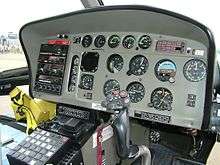
The AS350 is a single engine helicopter, powered either by a Lycoming LTS101 or Turbomeca Arriel powerplant (for twin-engined variants, see Eurocopter AS355), that drives a three-blade main rotor, which is furnished with a Starflex rotor head. The type is well known for its high-altitude performance and has seen frequent use by operators in such environments.[6] Both the main and tail rotors make use of composite material and are deliberately designed to minimize corrosion and maintenance requirements.[11] The AS350 was also developed to comply with the stringent noise requirements in place in locations such as national parks; the in-cabin noise levels are such that passengers may also readily converse during flight. The aircraft can also be quickly started up and shut down, which is often useful during emergency medical services roles.[11] It is equipped with hydraulically-assisted flight controls; these controls remain operational, albeit operated with greater physical difficulty, in the event of a hydraulic failure.[12]
Much of the AS350's avionics are provided by Garmin, such as the GI 106A course-deviation indicator, GNS 430 VHF/VOR/localizer/glideslope indicator/Global Positioning System receiver, GTX 327 Mode A and C transponder, and GMA 340H intercom.[11] The Vehicle and Engine Multifunction Display (VEMD) and the First Limit Indicator (FLI) both serve to increase the aircraft's safety during flight, reducing the number of gauges that need to be monitored by the pilot and thereby reducing their workload.[13] For increased smoothness in flight, which positively affects passenger comfort as well as safety, stability augmentation systems can be installed. Later-production aircraft feature new avionics and systems such as the integration of an Automatic Flight Control System (AFCS) and autopilot, a glass cockpit featuring three liquid-crystal displays (LCDs) and digital avionics, such as the synthetic-vision terrain mapping system and Airbus's Multibloc center console upon which various radios may be mounted.[6][14]

The AS350 has proven popular in a wide range of roles; as such, multiple cabin configurations can be used, between four and six passengers in a typical seating configuration, and large sliding doors can be fitted to either side of the cabin. In some operators' fleets, the furnishings of the cabin has been designed to enable the internal space and/or equipment fit-out to be rapidly reconfigured to enable aircraft to be switched between diverse operational roles.[6] Public service operators, such as those in law enforcement, often have forward looking infrared (FLIR) cameras and other mission systems installed on their aircraft. Other optional equipment on offer to operates had included real-time data links, rescue hoists, underslung cargo hooks, electrical external mirrors, search lights, tactical consoles, night vision goggle-compatibility, moving-map system, internal cabin tie-downs, second battery kit, sand filters, wire strike protection system, 4-channel radio, tail rotor arch, cabin floor windows, and removable seats.[6][13]
Modern aircraft have various refinements beyond those featuring on older models; these changes include dual-channel FADEC-equipped engines, increasing use of digital avionics in the cockpit, decreased maintenance costs, a re-designed cabin, and a comfortable Stylence interior (optional).[6][13] Older aircraft often undergo refurbishment programs to install aftermarket features, or for the addition of functionality common to newer production aircraft, such as retrofitting of the glass cockpit.[14]
Operational history

On 14 May 2005, an AS350 B3 piloted by Eurocopter test pilot Didier Delsalle touched down on the top of Mount Everest, at 8,848 m (29,030 ft).[15][16][17] this record has been confirmed by the Fédération Aéronautique Internationale.[18] On 29 April 2010, a stripped-down AS350 B3 rescued three Spanish alpinists, one at a time, from the slopes of Annapurna I, Nepal at an altitude of 6,900 m (22,640 ft); this set a new record for the highest such rescue.[19] The record was increased to 7,800 m (25,590 ft), during the rescue of Sudarshan Gautam between Camps III & IV in Everest's Yellow Band on the morning of 20 May 2013.[20][21][22][23] On 2 June 2014, an AS350 B3e broke a national record in Mexico by successfully landing on the peak of Pico de Orizaba, the nation's tallest mountain.[24]
The AS350 AStar has been successful in the US market, having become the most popular helicopter platform in use with individual American governmental agencies, law enforcement being a typical use of the type, by 2015.[25] By 1999, the AS350 had become the prime helicopter being used by the United States Customs Service for light enforcement operations;[26] by 2007, the agency had become the single largest operator of the type in the world.[27] By 2012, out of the 3,300 AS350s in operation across the world, 783 of them were in service with American-based operators.[28]
In the Russian market since 2006, the AS350 and other helicopters built by the manufacturer have been sold and supported by wholly owned subsidiary Eurocopter Vostok; UTair Aviation soon emerged as the largest Russian operator of the AS350 B3e with a fleet of at least 20 of the type.[29]
In December 2014, EASA validation was issued for Airbus Helicopters China to conduct training and support activity at their facility in Shenzhen, China; various components of the AS350 (such as the main and tail gearboxes) are now maintained locally.[30] On 9 September 2015, China's first helicopter leasing company, CM International Financial Leasing Corp Ltd (CMIFL), placed an order for 100 Ecureuil-series helicopters, these are to be a mix of H125 and H130 helicopters.[31][32]
Brazil has been an extensive operator of the AS350; by 2011 more than 300 helicopters were operating in the country in various conditions and roles, including from the flight deck of the Brazilian aircraft carrier São Paulo.[14][33] Since 1984, the Brazilian Navy has used AS350s to support the Brazilian Antarctic Program.[34] Helibras, a wholly owned subsidiary of Eurocopter, operates in the country; of the 600 helicopters it had domestically manufactured for the Brazilian market by 2012, 70% were AS350s.[35] In January 2011, Helibras signed a contract with the Brazilian Army to substantially upgrade and refurbish their existing fleet of 36 AS350 Ecureuils.[36]
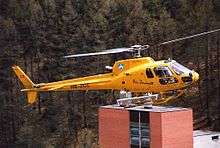
In the United Kingdom, the Defence Helicopter Flying School has operated 26 AS350, designated Squirrel HT1, for the training of pilots of Britain's armed forces; the type was progressively introduced from 1997 onwards as a replacement for the Aérospatiale Gazelle.[37] In September 2014, the UK's Ministry of Defence issued a request for proposals to replace the Squirrel HT1; Airbus Helicopters has already announced its intention to offer a mixed fleet of Eurocopter EC130s and Eurocopter EC135s in response.[38] Since May 1984, the Royal Australian Navy's Fleet Air Arm has operated a fleet of AS350s, these were upgraded to the AS350 BA standard in 1995; the Royal Australian Air Force had previously operated the AS350 for training purposes, and briefly for search and rescue missions, but these were later transferred to the Australian Army.[39]
Between June 2007 and December 2007, the Danish Air Force operated a deployment of four AS350 helicopters at Basra International Airport, Iraq, to perform liaison and reconnaissance missions in support of coalition forces during the Iraq War.[40] In June 2015, the Argentine Defense Ministry ordered 12 H125s to replace their 1970s era Aérospatiale SA 315B Lamas for para-public support missions, such as search and rescue operations, inside Argentina.[41]
Variants
- AS350
- Prototype.
- AS350 Firefighter
- Fire fighting version.
- AS350B
- Powered by one Turbomeca Arriel 1B engine.
- AS350 B1
- Improved version of the original AS350B, which is powered by one Arriel 1D engine, type also fitted with AS355 main rotor blades, AS355 tail rotor with tabs and a tail rotor servo.
- AS350 B2
- Higher gross weight version powered by one Arriel 1D1 engine over the B1 version with aerodynamic strake fitted to tail boom along the starboard side and angled engine exhaust duct for better yaw control.
- AS350 B3
- High-performance version, is powered by an Arriel 2B engine equipped with a single channel (DECU) Digital Engine Control Unit with a mechanical backup system. This helicopter is the first ever to land on the summit of Mount Everest. AS350 B3/2B1 variant introduces enhanced engine with dual channel (FADEC) Full Authority Digital Engine Control, dual hydraulics and a 2,370 kg (5,225 lb) Maximum Take Off Weight. AS350 B3e (introduced late 2011) equipped with the Arriel 2D engine.
- AS350 BA
- Powered by a Arriel 1B engine and fitted with wider chord AS355 main rotor blades and tail rotor servo.
- AS350 BB
- AS350 B2 variant selected to meet rotary-wing training needs of UK MoD, through its Defence Helicopter Flying School in 1996. Powered by a derated Arriel 1D1 engine to improve the helicopters' life cycle.
- Eurocopter Squirrel HT.1
- Designation of AS350BB in operation with British Military, through the Defence Helicopter Flying School as a training helicopter.
- Eurocopter Squirrel HT.2
- Designation of AS350BB in operation with British Army Air Corps as a training helicopter, based at Middle Wallop.
- AS350 C
- Initial variant of Lycoming LTS-101-600A2 powered version developed for the North American market as the AStar. Quickly superseded by AS350D.
- AS350 D
- Powered by one Lycoming LTS-101 engine for the North American market as the AStar. At one stage marketed as AStar 'Mark III.'
- AS350 L1
- Military derivative of AS350 B1, powered by a 510kW (684shp) Turbomeca Arriel 1D turboshaft engine. Superseded by AS350 L2.
- AS350 L2
- Military derivative of AS350 B2, powered by a 546 kW (732shp) Turbomeca Arriel 1D1 turboshaft engine. Designation superseded by AS550 C2.
- HB350 B Esquilo
- Unarmed military version for the Brazilian Air Force. Brazilian designations CH-50 and TH-50. Built under licence by Helibras in Brazil.
- HB350 B1 Esquilo
- Unarmed military version for the Brazilian Navy. Brazilian designation UH-12. Built under licence by Helibras in Brazil.
- HB350 L1
- Armed military version for the Brazilian Army. Brazilian designation HA-1. Built under licence by Helibras in Brazil.
Aftermarket conversions
- Soloy SD1, Super D
- AS350 BA powered by an LTS101-600A-3A engine.
- Soloy AllStar
- AS350 BA powered by a Rolls Royce 250-C30 engine.
- Soloy SD2
- AS350 B2 powered by an LTS101-700D-2 engine.
- Heli-Lynx 350FX1
- AS350 BA powered by an LTS101-600A-3A engine.
- Heli-Lynx 350FX2
- AS350 BA or AS350 B2 powered by an LTS101-700D-2 engine.
- Otech AS350BA+
- AS350 BA powered by an LTS101-600A-3A engine.[42]
Operators
The AS350 is in service around the world operated by private individuals, airline and charter operators, emergency medical teams, governments and law enforcement agencies.
Military and government operators
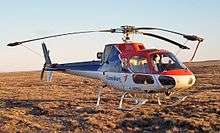

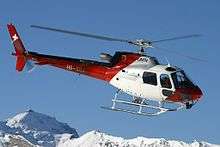


- Brazilian Air Force[45]
- Brazilian Navy[45]
- Military Police of São Paulo State[46]
- Military Police of Minas Gerais State[47]
- Baltimore County Police Department[56]
- California Highway Patrol[57]
- Customs and Border Protection[58][59]
- Los Angeles Police Department[60]
- Los Angeles County Sheriff's Department[61]
- Oklahoma City Police Department[62]
Notable accidents and incidents
- On 14 December 2004 an AS350 B3 medical transport helicopter operated by Air Evac of Arizona crashed on final approach while attempting to land on an emergency scene in Apache Junction, Arizona. Flight Medic Doreen Renee Johnson, 26, was killed on impact. The pilot Susanna Corcoles and Flight Nurse Kelly Foster-Stopka sustained serious but non-life-threatening injuries.[63]
- On 27 July 2007, two AS350s collided in mid-air while reporting a police pursuit. The two helicopters were part of KNXV-TV and KTVK television stations in Phoenix, Arizona. Four crew members were killed in this accident.[64]
- On 15 September 2007, former World Rally Championship driver Colin McRae and three passengers were killed when his AS350 B2 Squirrel,[65] which he was piloting, crashed near Lanark, Scotland.[66][67]
- On 8 August 2009, a Piper PA-32R collided with an AS350 over the Hudson River, with both aircraft crashing into the Hudson River. There were no survivors from the crash.
- On 29 April 2011, a Pawan Hans AS350 B-3 helicopter carrying Dorjee Khandu, the Chief Minister of Arunachal Pradesh, and four other people, went missing. It was traced four days later near Lobthang. All five people were found dead
- On 10 June 2012, an AS350 B3e[68] belonging to the Kenya Police Air Wing crashed in Kibiku area in Ngong Forest, west of Nairobi, Kenya, killing at least six people, including Kenya's Interior Security Minister George Saitoti and his deputy Orwa Ojode.[69][70]
- On 31 March 2013, an AS350 B3 Astar belonging to the Alaska State Troopers crashed[71] near Talkeetna, Alaska, killing all three aboard. The helicopter was on a rescue mission to recover an injured snowmobiler. The crash also claimed the life of an Alaska State Trooper.
- On 22 October 2013, an AS350 B3 medical transport helicopter operated by Memphis, Tennessee-based Hospital Wing crashed near Somerville, Tennessee, while en route to Bolivar, Tennessee. Three personnel onboard (one Hospital Wing pilot and the medical team of one flight nurse and one respiratory therapist from Le Bonheur Children's Hospital) were killed in the accident.[72]
- On 18 March 2014, an AS350 B2 owned by Helicopters Inc. and being used as a temporary replacement by KOMO-TV and KING-TV in Seattle, Washington, crashed across the street from the Fisher Plaza while attempting to take off from the rooftop of the studios of KOMO. The two people on board, pilot Gary Pfitzner and photographer Bill Strothman, were killed. The sole occupant of a passenger car onto which the helicopter fell was severely burned and taken to Harborview Medical Center. Two additional vehicles caught fire from the burning fuel, but the drivers escaped injury. According to eyewitnesses and security camera recordings, the helicopter yawed 360 degrees and pitched down while attempting to lift off the helipad.[73]
- On 7 June 2014, a Helibrás HB-350BA crashed after takeoff, in Aruanã, Goiás state, Brazil. All on board died, including retired soccer player Fernandão.[74]
- On 9 March 2015, two AS350 B3 collided mid air in La Rioja Province, Argentina, killing all 10 people on board both aircraft. The passengers, including a number of French athletes, were participants in the filming of French reality television program Dropped.
- On 2 June 2015, a Mountain Helicopters helicopter (9N-AJP) crashed in a forest in Yamuna village of Sindhupalchok district Nepal, killing at least five people. The helicopter had flown to Sindhupalchok to distribute relief materials to earthquake victims.[75][76]
- On 18 November 2015, an AS350 crashed at McClellan–Palomar Airport southeast of Carlsbad in San Diego County, California killing the pilot and one passenger.[77][78]
- On 21 November 2015, a New Zealand Alpine Adventures helicopter crashed into a crevasse on Fox Glacier, New Zealand, killing all 7 people on board.[79]
- On 23 November 2015, an AS350 B3 helicopter owned by Himalayan Heli Services registered VT-JKB crashed after takeoff at Katra, Jammu and Kashmir in India, killing 7 people including 6 Vaishno Devi pilgrims and the pilot.[80][81]
- On 5 May 2016, an AS350 B3 helicopter with registration RP-C6828 crashed on The island of Borneo, Malaysia shortly after take off from Betong. The passengers were three Malaysian officials, the husband of a minister and one bodyguard. No survivors are found as of 6 May.[82]
- All seven on board including a newborn, five adults and captain died in a Fishtail Air helicopter crash in Madanpur of Nuwakot district of central Nepal on August 8, 2016
- On March 26, 2016, an AS350 B2 medical transport helicopter operated by Haynes Life Flight in Wetumpka, Alabama, crashed after picking up a critical patient from a car accident in a swampy wooded area near Enterprise, AL. All 3 crew and 1 patient were killed in the accident.
- On November 1, 2016, an AS350 crashed in to private residence in Sochi (Russia) with death of 1 person.
Specifications (AS350 B3)
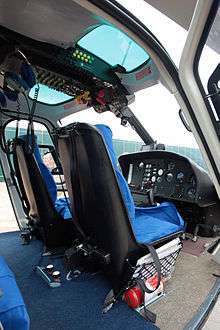
|
| |
|
| |
|
|
Data from Brassey's World Aircraft & Systems Directory 1999/2000[83]
General characteristics
- Crew: 1
- Capacity: 5
- Length: 10.93 m[84] (35 ft 10½ in)
- Rotor diameter: 10.7 m (35 ft 1 in)
- Height: 3.14 m (10 ft 3½ in)
- Disc area: 89.75 m² (966.1 sq ft)
- Empty weight: 1,174 kg (2,588 lb)
- Max. takeoff weight: 2,250 kg (4,960 lb)
- Powerplant: 1 × Turbomeca Arriel 2B turboshaft, 632 kW (847 shp)
Performance
- Never exceed speed: 287 km/h (155 knots, 178 mph)
- Cruise speed: 245 km/h (132 knots, 152 mph)
- Range: 662 km (357 nmi, 411 mi)
- Endurance: 4.1 hrs
- Service ceiling: 4,600 m (15,100 ft)
- Rate of climb: 8.5 m/s (1,675 ft/min)
Avionics
Vehicle and Engine Monitoring Display (VEMD) with First Limit Indicator (FLI) fitted as standard.
† 4, 5, & 6 passengers options available.[85] The 6 passenger configuration is a relatively uncommon high-density seating option that replaces one front seat with a two-person bench and relocates the pilot to the left side of the cockpit.[86]
See also
- Related development
- Aircraft of comparable role, configuration and era
- Related lists
References
Citations
- ↑ "Eurocopter AS350, AS355 & EC130 Technical Briefing.", Airbus Helicopters, February 2010.
- ↑ Fabre, François et al., "Final Report: Eurocopter AS350 Ecureuil/Single Engine Family, Revision 4.", European Aviation Safety Agency, 8 June 2012.
- 1 2 3 4 5 "1974: AS350/355 Ecureuil/AStar- AS550/555 Fennec - EC130." Eurocopter, Retrieved: 25 December 2015.
- ↑ Jackson 2003, p. 244.
- ↑ Taylor 1982, p. 56.
- 1 2 3 4 5 6 Lombardi, Frank. "AStar Evolution.", Aviation Today, 12 May 2015.
- ↑ Osborne, Tony. "French Unions Dislike Eurocopter’s U.S. AS350 Plan.", Aviation Week, 30 September 2013.
- ↑ "Eurocopter to assemble AS350 aircraft in Mississippi.", United Press International, 23 September 2013.
- ↑ "First US-made Airbus Helicopters AS350 certified.", Aerospace Manufacturing and Design, 3 March 2015.
- ↑ Forrest, Ben. "Airbus aims to ramp up H125 production in Mississippi." Vertical Magazine, 22 December 2015.
- 1 2 3 Stephens, Ernie, and James T. McKenna. "The AS350 — Versatility and Power.", Rotor & Wing, 1 June 2007.
- ↑ "AS350: Hydraulics Out? Fly the Procedure.", Rotor & Wing, 1 June 2007.
- 1 2 3 "Civil: H125." Archived 11 September 2015 at the Wayback Machine. Airbus Helicopters, 2015.
- 1 2 3 "Eurocopter’s Helibras Subsidiary to Modernize 36 AS350 Ecureuil Helicopters Operated by the Brazilian Army Aviation Command.", Helicopter Maintenance Magazine, 1 February 2011.
- ↑ "Landing on Air". National Geographic Adventure. 1 September 2005. Archived from the original on 2 August 2009.
- ↑ The Helicopter land on Everest with video
- ↑ "French Everest Mystery Chopper's Utopia summit". MountEverest.net. 27 June 2005.
- ↑ "FAI Record ID #11596 – Highest take-off" Fédération Aéronautique Internationale (FAI). Retrieved: 20 September 2014.
- ↑ "Helicopter Rescues in Everest's Western CWM?". Retrieved 28 February 2012.
- ↑ Bierling, Billi (October 2013). "The height of folly?". Action Asia Magazine.
When he fell at the Yellow Band during his descent, Gautam then set another landmark: for the highest helicopter rescue in the world. The Italian pilot Maurizio Folini took on the daring task and used a ‘long line’ from 7,800 metres to pull the 30-year-old off the mountain. The rescue may also cost Gautam his place in the Himalayan Database as, according to Hawley’s criteria, his climb is not complete.
- ↑ Arnette, Alan (28 February 2014). "Everest 2014: Can I be Rescued on Everest?".
- ↑ Sottocornola, Sara (23 May 2013). "Everest, record superato: incredibile recupero vicino a campo 4 per Maurizio Folini". montagna.tv (in Portuguese).
- ↑ Wright, Brian (10 June 2013). "Daring High Altitude Rescue on Everest Sets Record". Rock and Ice, The Climber's Magazine.
- ↑ "AS350 B3e breaks record on Mexico's highest mountain.", Vertical Magazine, 2 June 2014.
- ↑ "Several California Law Enforcement Agencies to Use New AStar Model.", Rotor & Wing, 3 March 2015.
- ↑ "Congressional Record, V. 145, Pt. 11, July 1, 1999 to July 15, 1999.", Government Printing Office, pp. 15192-15193. Retrieved 5 June 2015.
- ↑ Schmidt-Creton, Vanessa. "Largest Astar Operator in the US.", Airbus Helicopters, 12 July 2007.
- ↑ "American Eurocopter Celebrates 200th American-Made AS350 Helicopter.", AviationPros, 20 September 2012.
- ↑ "Eurocopter Vostok Delivers First Enhanced AS350 B3e Helicopters for Utair Aviation, Which Will Become the Largest Ecureuil Operator in Russia and CIS." Eurocopter, 12 January 2012.
- ↑ "Airbus Helicopters Receives EASA Approval for Joint-Venture Training and Support in China.", Aviation Today, 15 December 2014.
- ↑ Wen, Wang. "Heli-Expo launches with huge order for Airbus.", China Daily, 9 September 2015.
- ↑ "China Heli-Expo 2015" (3): Chinese CMIFL sign agreement for 100 H-125/H-130 helicopters over five years.", AvioNews, 9 September 2015.
- ↑ "Zentech to support Brazilian aircraft carrier São Paulo’s upgrade programme.", naval-technology, 7 May 2015.
- ↑ Morant, Belen. "The Brazilian Navy: The Ecureuil in Antarctica.", Rotor Online, April 2009.
- ↑ "Eurocopter Unit Inaugurates Chopper Plant in Brazil.", defensenews, 2 October 2012.
- ↑ "Elixir of Youth for AS350", SavunmaSanayi.Net, 6 January 2011.
- ↑ "Squirrel HT1.", Royal Air Force. Retrieved 6 June 2015.
- ↑ Perry, Dominic. "UK MoD begins training helicopter acquisition.", Flight International, 10 September 2014.
- ↑ "Navy’s ‘Battle Budgie’ turns 30.", australianaviation.com.au, 30 May 2014.
- ↑ Ripley 2010, p. 297.
- ↑ Guevara, Inigo. "Argentina signs MoU for 12 Airbus Helicopters H125s.", IHS Jane's Defence Weekly, 29 June 2015.
- ↑ Reyno, Mike, "Power Play", Vertical December 2006
- ↑ "Ecureuil scores success in South America". eurocopter.com. Retrieved 17 February 2013.
- ↑ "Control and Prevention". Retrieved 18 December 2012.
- 1 2 3 4 5 6 7 8 9 10 11 12 13 14 15 16 17 "World Air Forces". Flightglobal Insight. 2015. Retrieved 28 March 2016.
- ↑ Lucchesi Air International June 2000, p. 377.
- ↑ "PMMG Aeronaves". Retrieved 29 March 2016.
- ↑ "R.C.M.P Helicopter". Retrieved 26 January 2005.
- ↑ "French National Gendarmerie AS350 ecureuil". Retrieved 17 February 2013.
- ↑ "Hungarian Air Force AS350 ecureuil". Retrieved 27 May 2015.
- ↑ "Iceland CG Aircraft". aeroflight.co.uk. Retrieved 17 February 2013.
- ↑ "Namibian Police Order EC145". Air International. Vol. 81 no. 4. October 2011. p. 34. ISSN 0306-5634.
- ↑ "Philippine National Police look to purchase 15 helicopters". HeliHub. 2012-10-12. Retrieved 2015-10-08.
- ↑ http://bmpd.livejournal.com/1906446.html
- ↑ Eurocopter Southern Africa Archived 6 April 2013 at the Wayback Machine.
- ↑ http://www.baltimorecountymd.gov/Agencies/police/aviation1.html
- ↑ "Airbus delivers six H125s to four California law enforcement agencies". helihub.com. Retrieved 29 March 2016.
- ↑ "Southwest Border Region/ CPB". cbp.gov. Retrieved 17 February 2013.
- ↑ "CPB AS 350". Demand media. Retrieved 17 February 2013.
- ↑ Why Is That LAPD Helicopter Circling Overhead?
- ↑ "LASD Aero Bureau". code2high.com. Retrieved 3 September 2014.
- ↑ "Oklahoma City Police Department unveils new helicopters". The Oklahoman. Retrieved 2015-12-26.
- ↑ "One Killed, 2 Injured When Arizona AirEvac Helicopter Crashes". Firehouse.com. 14 December 2004.
- ↑ "Archived copy". Archived from the original on 29 July 2007. Retrieved 19 September 2007.
- ↑ Civil Aviation Authority
- ↑ "Colin McRae feared dead in helicopter crash – police". Yahoo! News/AFP. Retrieved 16 September 2007.
- ↑ Rose, Gareth; Watson, Jeremy (16 September 2007). "Rally ace Colin McRae dies in helicopter crash". The Scotsman. Edinburgh. Retrieved 16 September 2007.
- ↑ Mukinda, Fred and Silas Apollo. "Chopper was 'new and powerful'". Daily Nation. 10 June 2012. Retrieved 13 June 2012.
- ↑ "Kenyan minister George Saitoti killed in helicopter crash". BBC News. 10 June 2012. Retrieved 10 June 2012.
- ↑ "Minister killed in Kenyan helicopter crash". aljazerra.com. 10 June 2012. Retrieved 10 June 2012.
- ↑ "Investigation begins into helicopter crash that killed three." Archived 6 April 2013 at the Wayback Machine. Anchorage Daily News . 1 April 2013. Retrieved 2 April 2013.
- ↑ http://www.commercialappeal.com/news/2013/oct/22/medical-helicopter-crashes-outside-somerville
- ↑ "WPR14FA137 – Preliminary Accident Report". 21 March 2014. Retrieved 21 March 2014.
- ↑ "Former Brazil and Internacional striker Fernandão dies in helicopter crash". 7 June 2014. Retrieved 7 June 2014.
- ↑ http://www.nepalitimes.com/blogs/thebrief/2015/06/02/helicopter-crash-in-sindhupalchok/
- ↑ http://nepaliaviator.com/helicopter-crash-in-sindhupalchowk-leaves-4-dead/
- ↑ http://www.cbs8.com/story/30553994/two-killed-in-helicopter-crash-at-palomar-airport-identified
- ↑ http://www.thecoastnews.com/2015/11/19/two-men-killed-in-helicopter-crash/
- ↑ https://www.rt.com/news/322952-nz-helicopter-crash-glacier/
- ↑ http://indiatoday.intoday.in/story/helicopter-crash-kills-6-near-katra/1/529355.html
- ↑ "Archived copy". Archived from the original on 23 November 2015. Retrieved 2015-11-23.
- ↑ "Liow: Chopper services not grounded in S'wak despite crash". freemalaysiatoday.com. 6 May 2016. Retrieved 6 May 2016.
- ↑ Taylor 1999, p. 377.
- ↑ Fuselage length
- ↑ http://www.eurocopter.com/site/en/ref/Overview_68.html
- ↑ http://www.trykauai.com/astar-seats.gif
Bibliography
- Hoyle, Craig. "World Air Forces Directory". Flight International. Vol 180 No 5321, 13–19 December 2011. pp. 26–52.
- Jackson, Paul. Jane's All The World's Aircraft 2003–2004. Coulsdon, Surry, UK: Jane's Information Group, 2003. ISBN 0-7106-2537-5.
- Lucchesi, Claudio. "Brazilian Police Air Unit: São Paulo's Police Eagles". Air International, June 2000, Vol. 58, No. 6. pp. 376–378.
- Ripley, Tim. Middle East Air Power in the 21st Century. Casemate Publishers, 2010. ISBN 1-8488-4099-3.
- Taylor, John W. R. Jane's All The World's Aircraft 1982–83. London: Jane's Yearbooks, 1982. ISBN 0-7106-0748-2.
- Taylor, Michael J. H. Brassey's World Aircraft & Systems Directory 1999/2000. London: Brassey's, 1999. ISBN 1-85753-245-7.
Further reading
- Croucher, Phil. The AS 350/355 Book. Lulu.com, 2014. ISBN ISBN 1-92683-319-8.
External links
| Wikimedia Commons has media related to Airbus Helicopters AS350 Ecureuil. |
